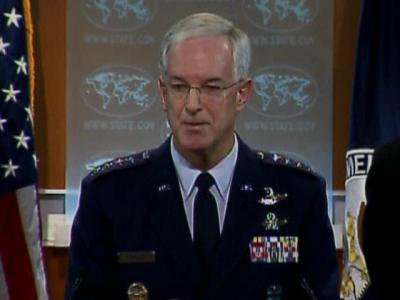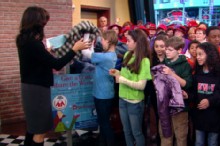PORT-AU-PRINCE, Haiti – Dazed survivors wandered past dead bodies in rubble-strewn streets Wednesday, crying for loved ones, and rescuers desperately searched collapsed buildings as fear rose that the death toll from Haiti's devastating earthquake could reach into the tens of thousands.
The first cargo planes with food, water, medical supplies, shelter andsniffer dogs headed to the Western Hemisphere's poorest nation a day after the magnitude-7 quake flattened much of the capital of 2 million people.
Tuesday's earthquake brought down buildings great and small — from shacks in shantytowns to President Rene Preval's gleaming whiteNational Palace, where a dome tilted ominously above the manicured grounds.
Hospitals, schools and the main prison collapsed. The capital's Roman Catholic archbishop was killed when his office and the main cathedral fell. The head of the U.N. peacekeeping mission was missing in the ruins of the organization's multistory headquarters.
Police officers turned their pickup trucks into ambulances to carry the injured. Wisnel Occilus, a 24-year-old student, was wedged between two other survivors in a truck bed headed to a police station. He was in an English class when the earth shook at 4:53 p.m. and the building collapsed.
"The professor is dead. Some of the students are dead, too," said Occilus, who suspected he had several broken bones. "Everything hurts."
Other survivors carried injured to hospitals in wheelbarrows and on stretchers fashioned from doors.
In Petionville, next to the capital, people used sledgehammers and their bare hands to dig through a collapsed shopping center, tossing aside mattresses and office supplies. More than a dozen cars were entombed, including a U.N. truck.
Nearby, about 200 survivors, including many children, huddled in a theater parking lot using sheets to rig makeshift tents and shield themselves from the sun in 90-degree heat.
At a triage center improvised in a hotel parking lot, people with cuts, broken bones and crushed ribs moaned under tent-like covers fashioned from bloody sheets.
"I can't take it anymore. My back hurts too much," said Alex Georges, 28, who was still waiting for treatment a day after his school collapsed and killed 11 classmates. A body lay a few feet away.
"This is much worse than a hurricane," said doctors' assistant Jimitre Coquillon. "There's no water. There's nothing. Thirsty people are going to die."
If there were any organized efforts to distribute food or water, they were not visible.
The aid group Doctors Without Borders treated wounded at two hospitals that withstood the quake and set up tent clinics elsewhere to replace its damaged facilities. Cuba, which already had hundreds of doctors in Haiti, treated injured in field hospitals.
Bodies were everywhere in Port-au-Prince: those of tiny children adjacent to schools; women in the rubble-strewn streets with stunned expressions frozen on their faces; men hidden beneath plastic tarps and cotton sheets.
Haiti's leaders struggled to comprehend the extent of the catastrophe — the worst earthquake to hit the country in 200 years — even as aftershocks reverberated.
"It's incredible," Preval told CNN. "A lot of houses destroyed, hospitals, schools, personal homes. A lot of people in the street dead. ... I'm still looking to understand the magnitude of the event and how to manage."
Preval said thousands of people were probably killed. Leading Sen. Youri Latortue told The Associated Press that 500,000 could be dead, but conceded that nobody really knows.
"Let's say that it's too early to give a number," Preval said.
As dusk fell, thousands of people gathered on blankets outside the crumpled presidential palace, including hundreds of women who waved their hands and sang hymns in a joyful, even defiant tone.
Ricardo Dervil, 29, said he decided to join the crowd because he was worried about aftershocks and was tired of seeing dead bodies.
"I was listening to the radio and they were saying to stay away from buildings," he said. "All I was doing was walking the street and seeing dead people."
Balancing suitcases and belongings on their heads, people streamed on foot into the Haitian countryside, where wooden and cinderblock shacks showed little sign of damage. Ambulances and U.N. trucks raced in the opposite direction, toward Port-au-Prince.
About 3,000 police and international peacekeepers cleared debris, directed traffic and maintained security in the capital. But law enforcement was stretched thin even before the quake and would be ill-equipped to deal with major unrest. The U.N.'s 9,000-member peacekeeping force sent patrols across the capital's streets while securing the airport, port and main buildings.
Looting began immediately after the quake, with people seen carrying food from collapsed buildings. Many lugged what they could salvage and stacked it around them as they slept in streets and parks.
President Barack Obama promised an all-out rescue and humanitarian effort including the military and civilian emergency teams from across the U.S. Late Wednesday, the Navy said the amphibious assault ship USS Batann had been ordered to sail as soon as possible with a 2,000-member Marine unit to join other warships headed to the Caribbean nation.
"We have to be there for them in their hour of need," Obama said.
The first C-130 plane carrying part of a U.S. military assessment team arrived in Haiti, the U.S. Southern Command said. The aircraft carrier USS Carl Vinson was expected to arrive off the coast Thursday and moreU.S. Navy ships were under way.
A U.S. Coast Guard helicopter evacuated four critically injured U.S. Embassy staff to the hospital at the U.S. naval base at Guantanamo Bay, Cuba, where the military has been detaining suspected terrorists.
A small contingent of U.S. ground troops could be on their way soon, although it was unclear whether they would be used for security operations or humanitarian efforts.
Port-au-Prince's ruined buildings fell on both the poor and the prominent: The body of Archbishop Joseph Serge Miot, 63, was found in the ruins of his office, according to the Rev. Pierre Le Beller at Miot's order, the Saint Jacques Missionary Center in Landivisiau, France.
The United Nations said 16 U.N. personnel were confirmed dead and between 100 and 150 U.N. workers were still missing, including U.N. mission head Hedi Annabi of Tunisia and his chief deputy, Luis Carlos da Costa.
Senate President Kelly Bastien was rescued from the collapsed Parliament building and taken to a hospital in the neighboring Dominican Republic. The president of Haiti's Citibank was also among the survivors being treated there, said Rafael Sanchez Espanol, director of the Homs Hospital in Santiago.
An American aid worker was trapped for about 10 hours under the rubble of her mission house before she was rescued by her husband, who told CBS's "Early Show" that he drove 100 miles (160 kilometers) to Port-au-Prince to find her. Frank Thorp said he dug for more than an hour to free his wife, Jillian, and a co-worker, from under about a foot of concrete.
Even the main prison in the capital fell down, "and there are reports of escaped inmates," U.N. humanitarian spokeswoman Elisabeth Byrs said in Geneva.
Haiti seems especially prone to catastrophe — from natural disasters like hurricanes, storms, floods and mudslides to crushing poverty, unstable governments, poor building standards and low literacy rates.
The survivors likely will face an increased risk of dengue fever, malaria and measles — problems that plagued the impoverished country before, said Kimberley Shoaf, associate director of the UCLA Center for Public Health and Disasters.
Some of the biggest immediate health threats include respiratory disease from inhaling dust from collapsed buildings and diarrhea from drinking contaminated water.
The international Red Cross said a third of the country's 9 million people may need emergency aid, a burden that would test any nation and a crushing catastrophe for impoverished Haiti.
The U.S. Embassy had no confirmed reports of deaths among the estimated 40,000 to 45,000 Americans who live in Haiti, but many were struggling to find a way out of the country.
The quake damaged the airport, stranding dozens there. Kency Germain of Eatontown, N.J., kept his family — five adults and three children — at the airport until nearly 3 a.m. They made their way to the U.S. Embassy, where they were allowed to sleep briefly near the entrance.
"It was safer in there (the airport) than it was out there in Port-au-Prince," Germain said.
___
Associated Press contributors to this story: Mike Melia and Jennifer Kay in Port-au-Prince; Edith M. Lederer at the United Nations; Frank Jordans and Bradley S. Klapper in Geneva; Matthew Lee and Julie Pace in Washington; Jamey Keaton in Paris; Tales Azzoni in Sao Paulo; Alicia Chang in Los Angeles, and Andrea Rodriguez in Havana.





1 comment:
This is really a well laid out website. I like how you have presented the information in full detail. Keep up the great work and please stop by at my site sometime. Keep it up..
Studies using nitrile exam gloves have shown that they also greatly reduce irritations as well as infections.
They are very comfortable to wear and can actually be worn for extended periods of time.
Post a Comment